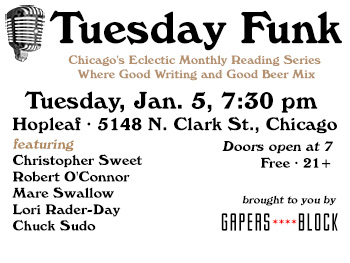| « Chicanas of 18th Street @ Women and Children First | Bookmarks » |
Book Club Fri Dec 02 2011
In Case You Missed It: "What makes a beautiful (and marketable) book?"
We're all told not to "judge a book by its cover" from a very young age, and though it's an appropriate warning to young readers, the book is usually a metaphor for something else. During last night's edition of Artists at Work, entitled, "What makes a beautiful (and marketable) book?" books were definitely books, and listeners learned to toss that aging adage out the window.
The panel discussion was held at the Cultural Center, and moderated by the head of Publishing Industry Programs for the Department of Culture and Tourism, Danielle Chapman. The prestigious panel ran the gamut from a marketing expert to those on the creative end; Design Director for the MCA James Goggin; University of Chicago Press Marketing Manager Ellen Gibson; and founder of Stepsister Press, artist, and book designer, Annie Heckman weighed in on the fundamental importance of book design.
Heckman projected multiple covers for Albert Camus' The Stranger to highlight the role a book designer plays in selectively relaying content to potential readers, or at times withholding everything.
"You're a translator, translating the interior world of the book," Heckman said. "You work with the author directly on their vision, and then there's the moment that someone sees it and wants to pick it up. You're a translator between these two sides."
In one cover of The Stranger displayed on the projector, the designer chose to focus on the quality of the translation, while another featured a drawing of a man on a beach, depicting the narrator at a pivotal moment. Heckman pointed out that these choices are about the audience the particular publisher is looking to attract.
Goggin described his methods for developing cover concepts while working in the design department at Random House. While freelancing, he said he insisted on reading every book he was assigned to design, much to the surprise of many of his colleagues.
"The crucial starting point is to read the book," Goggin said. "Then I would search for the little detail [for the cover] that two thirds in, the reader would understand. It must be inviting to pick up in the first place, and in this way, the form is the function."
The conversation turned to technology with digital printing. Gibson discussed the Print on Demand side of digital printing using the example of Academically Adrift, which received loads of attention after having posited that children no longer really learn anything in school. The unexpected high demand for the book, Gibson said, hammered home the potentials of on demand printing.
"Our print on demand facility works well for books that have gone out of print," she said. "It also helped us meet customer demand with Academically Adrift. We sold out immediately but we were able to get books in customers' hands."
Goggin added to the discussion noting that digital printing is inexpensive compared to offset printing, which requires pricey plates. He said it is a particularly useful avenue for self-publishers who cannot afford traditional print methods.
Such changes, all three agreed, alter their respective roles. Goggin mentioned having a publisher question his book design based on its effectiveness when viewed in miniature on Amazon.com. No matter the medium, Heckman said there is a special equilibrium that book designers seek.
"There's an expectation that is should stand out, like junk mail," Heckman said. "Junk mail shouts at you. On the other hand, there's a possibility of picking a book up and having no idea what it's about. It's a balancing act."









